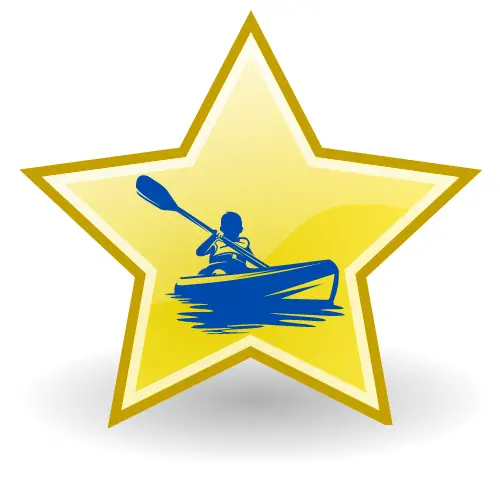Ever wondered how to kayak with a dog? If you’ve never done this, but dream of taking your furry best friend out into the water, then our article will help prepare you for any scenario.
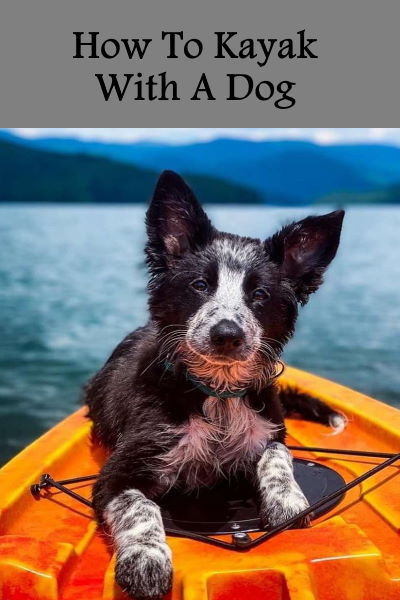
It’s certainly not as easy as putting them on the board and then walking away, but with proper preparation and training, it is definitely doable.
That’s why we’ve put together top tips, along with a few ideas to think about, to help you enjoy a peaceful time in the water with dog lovers.
Table of Contents
How can you prepare your dog to kayak with you?
Before even thinking about going out on the water there’s a great deal of planning involved in making sure that your dog is prepared to kayak.
There are some things you’ll need to try out and do some practice with your dog in the safety of a solid surface. This will make sure that you are aware of what to expect from your dog before you plunge towards the pool.
Here are some suggestions for preparing your dog to kayak:
- Make sure your dog pays attention to your instructions. Being able to comprehend “sit,” “stay,” and “lay down” are all essential to ensure that your dog behaves on water (this is the case for sailing as well). If your dog hasn’t learned these basic commands, begin at the beginning. Be sure that your dog is able to be attentive while swimming to avoid a sudden capsize!
- Get your dog used to your kayak on dry ground. Your dog should sit alongside you on the shore or in your backyard prior to placing it in the water. This will make him feel at ease before adding another aspect floating in the water.
- Try swimming with your pet. Is your pet at ease on the surface? This is an essential aspect to ensure a safe kayaking adventure. It is important to ensure that your dog is able to return to you in case the dog sit falls off. You should also make sure that he is comfortable and excited to be at sea!
Quality Time With Your Best Friend
Sometimes, it’s nice to set the time aside to spend time with your beloved pet. Sure, you’ll be paddling and thinking about other things sometimes but your dog will be grateful for spending quality time with you. In the end, they may be your best friend, but you’re the center of their universe.
Dogs are also able to detect the smells and sounds earlier than humans can, and their instinct to defend and alert their masters can be extremely beneficial in the wilderness.
Getting the Right Dog-Friendly Kayak
Even if you’re a seasoned kayaker and can handle a dog, kayaking with a dog is a bit of a challenge.
It is important to ensure that you’ve got the appropriate dog lovers kayak that is suitable for a pet-friendly passenger. It’s not the right moment to test small whitewater boats that can float on the swifts.
Pick a boat with an open, flat bottom and a big cockpit that has plenty of room for your pet. These boats will also be more stable and you won’t need to worry about crashing.
You could also give your pet a place to sit by making use of tandem kayaks and let him go for a paddle with fashion!
Few Tips To Keep Your Pooch Safe And Happy When Paddling
An excitable dog that is hyper can be a challenge at the most challenging of instances. A leisurely stroll in the park can quickly turn into a massacre of pigeons if you don’t have the proper planning and vigilance.
Add this number to a thousand and you’ll realize how important that you are well-prepared and organized prior to you taking your dog for their first kayaking adventure.
Here are a few things to keep in mind before you begin the journey into the water…
Is Your Dog Suitable For Kayaking?
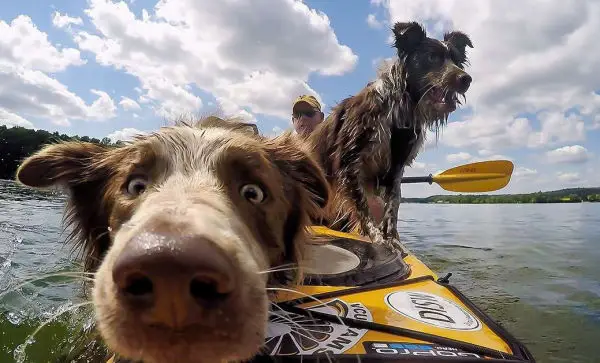
It’s true there are dogs that do not like water. Water isn’t suitable for all (humans including). However, most dogs believe that it’s not a big deal. But with determination and perseverance, even the dogs that are most water-resistant can learn to relax and enjoy the kayaking lifestyle. However, the one thing you don’t want to see is your dog jumping into the ocean when you’re in the middle of nowhere.
A few things to take into consideration about your dog prior to taking him out into the water include:
Personality and Temperament Do you have a dog that is active and excited? Do you think it will run over the yak at the slightest movement, or is it able to lie at a comfortable seated position for prolonged durations while you relax with a paddle?
Breed and Size It doesn’t take an expert to understand that big strong dogs could capsize the kayak quite quickly. A large dog with an overly exaggerated personality may be difficult to manage and maneuver around. It is important to think about the possibility of your dog making it or even on your kayak (especially bigger dogs) and if they’re easy to control and command.
Health & Age It is a given that the health of your dog comes first. If your dog is suffering from vision impairment, arthritis hearing loss, or other cardiac problems, you’ll have to be aware of these before going on the boat.
The temperature and weather will vary on the water, so you must ensure that your dog is healthy and fit enough to withstand the elements. You might also want to consult with your veterinarian prior to you introducing your dog to kayaking in order to keep your dog safe.
The bodies of water are usually breeding grounds for mosquitoes and other insects that carry diseases. Your dog might get a benefit from vaccinations.
Pre-Season Training
It’s not just the case for elite athletes. If you’re considering having your dog go on the water, it’s important to conduct some preparatory activities to help prepare your dog physically and mentally for the challenge ahead. This may be a bit difficult initially, however, there are a few guidelines that can make the process more manageable later on.
The first step is to be required to make sure your dog responds to basic commands. You can do this by training your dog to obey self-control. If you encounter an animal that is exciting (whether it’s fish, dolphins, or even a human) You must ensure that you regulate your dog’s behavior and stop being over-excited.
The best commands to use can be “Stay” and “Leave it”.
It is possible to practice this by taking your dog out on trails that are busy and teaching them to remain at your side and avoid the attractive, shiny new object in the vicinity.
If you do not grasp these easy instructions, you could be in a position similar to that…
It is also important to make sure that they are comfortable with your kayak and equipment for kayaking on the solid ground prior to heading out onto the water. Dog sit in the kayak to familiarize them with the layout and scent. It is also possible to allow your dog to swim in an aquatic pool.
Learn to get into and out of the kayak (with your dog, of course) in your living room, garage, or even in the garden. It may require a few times when they have trouble getting their front legs up on the deck. This is easier when you use sit-on-top kayaks, which have wide cockpit openings, and plenty of room to move about. Tandem kayaks are also a good option for your pet to find the most comfortable place to sit with plenty of room to lie down in comparison to the other kinds of kayaks. Yoga mats are useful to provide additional cushioning on surfaces that are hard.
You are able to modify your commands based on what your dog’s routine is but the most effective phrases include “load, sit, stay, unload”.
If you’re about to let your dog experience an inflatable kayak start by focusing the initial outings on mastering your technique of “load, sit, stay, unload” on the water. Once you’re prepared to start your journey for the first time, make sure your dog remains in the kayak along with you for the initial few minutes. Keep in mind that they may not be aware of dock entry if they’ve only practiced at a beach or in the grass.
What to Do if Your Dog Jumps Ship
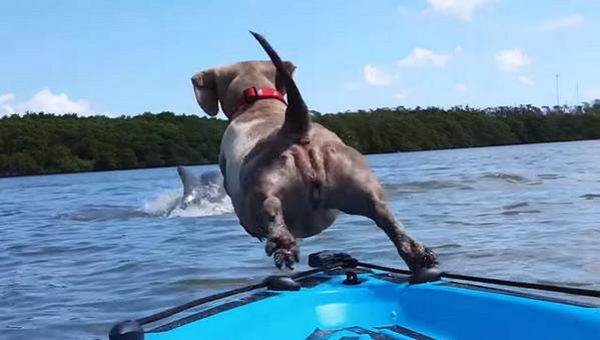
Even the most well-trained dog could get twitter-whipped by a seal, or a piece of kelp, such as Gracie the Dachshund dog in the video below, when she is able to spot the dolphins swimming in a group. This kind of thing could happen to anyone, and wearing a dog-friendly life jacket is crucial, because it aids immensely in the dog being pulled from the water to the kayak, and also gives you time to save your pet if they need to.
- If your dog darts off the kayak without permission, you must keep your voice in a calm tone, but remain not tense.
- Inform your children to “get in the boat” while you are paddling toward them.
- As you approach the paddle, raise it to ensure it doesn’t strike the dog or scare them. then lean forward and grab your dog’s hand with the handle of their jacket and get them on the board.
- If your dog doesn’t have a life jacket, put down your oar in order to prevent it from sinking into the water. Then take a step back then pull it in a parallel manner to the kayak. Try to calm them down a little by speaking in a manner that is soft.
- Place your arm over their back and then hook it between their front legs, to allow you to grab hold of them and get back onto the board, or at a minimum, lift them up enough off the water to be capable of climbing back up.
After your dog has returned to the boat, you can praise them and reward them with dog treats. The dog is thinking about the fact that they barely made it off the boat, and not what they did when they jumped off the boat without your permission So, ensure to know that you’ve done the right thing in returning to you. Certain many dogs will probably be out of kayaking when this event. Some dogs will just take the lumps and go on as if nothing ever happened.
What Type of Kayak Should I Use?
Kayaks, similar to dogs, come in various dimensions and shapes. You must ensure that you have a kayak large enough to allow you two in comfortably. It is best to have a place where your dog will be secured in the event of rough water. A tandem kayak is an ideal choice, as well as a sitting-on-top kayak, which offers convenience and makes it easier for you and your dog to walk into and out of.
We recommend that you read the article Best kayaks for dogs.
If your dog gets easily over the top, you might need some space between your legs, so that you can grasp a grip of their life jacket immediately when your dog jumps in the water. If the dog you have is calmer they may like to relax or lay on the bow and observe other paddlers as well as other boats.
There isn’t any specific guideline for what’s correct or incorrect… it’s based entirely on the dog’s size and breed, as well as temperament.
But, some canines have been found to be more content sitting on top kayaks (as opposed to sitting-in kayaks) so that they can move about more. A tandem kayak gives the two of you more space and enough space for your pet to take their own seat alongside you in the back. This makes these among the best kayaks for dogs.
Sit-on-top kayaks are also known to be more sturdy. However, you must be sure to stay clear of dangerous rapids when paddling with your pet. Calm water makes for an easier, safer (and less trauma-free) experience for the dog, and allows both of you to remain in a calm and peaceful kayak.
Kayaks (such as the Sea Eagle brand) can also be an option because they are very buoyant and sturdy. They are generally made of sturdy materials that are resistant to claws from dogs and claws, which makes them one of the best kayaks to keep your dog and yourself secured.
You can also find tandem boats that are inflatable and can offer more room for your pet and your kayaking gear.
What to Do If Things Don’t Go Well
If it’s a kayak with dogs, or paddling on your own Sometimes, kayaks tip. The fact that dogs are in the mix means there’s more than just re-entering the kayak. Here are some suggestions to deal with tipping
- Find your excited dog and keep them close
- Return to your kayak. Be sure to keep your dog close by and speak to them calmly. Don’t be afraid to frighten your dog by causing them to be annoyed or sound irritable. For your dog, as far as it is concerned both of you are going to go swimming together. There’s nothing to cause them to think of anything other than that.
- Make sure your kayak is set up. This could mean flipping it over so that it’s upside down or putting the paddle back in the boat.
- Put your dog in the kayak. Set their paws onto the kayak and then push into the kayak. Be sure to keep them calm and relaxed. They might not know what’s going on in their kayak but they’re not.
- When your dog is safe and you are confident, you can step to the edge of the boat. (If the dog you are bringing in is nervous, or you prefer to enter the kayak by yourself before dragging your dog in using the strap at the rear of their vest. However, many prefer to be confident the dog’s secure before attempting to re-enter for themselves.)
Kayaking Gear Necessary for Your Dog
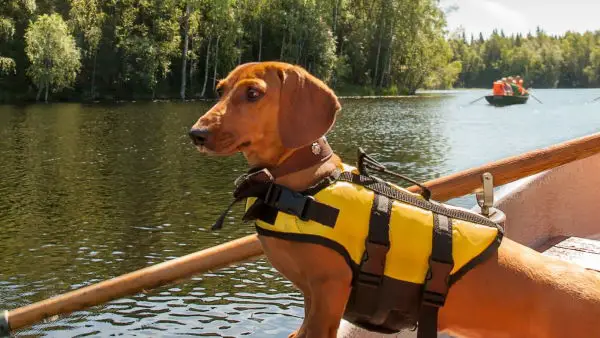
A kayaking trip with dogs requires some additional gear than paddling on your own. You’ll need to pack pet products to ensure that both you and your pet are safe and comfortable on your excursion.
- Life vests. It’s not hard to find special PFDs designed for pets. These life jackets are designed to be the right size (and designed) for your pet. They also include straps or handles on the back of the jacket to help get your dog from the water and back into the kayak life.
- Leash and harness. You should never put your dog in your boat. However, a leash and harness remain essential for your land trip. You could end up at the park or in a campground that requires leashes. Although your animal seems well-behaved, having them leashed and within reach can assist in protecting your pet from the other dogs who might not be.
- Water and food. Hydration is important for you and is particularly important for dogs who cannot get up to take water themselves. Even if you’re likely to be in a water-filled environment but it’s not good for your pet to drink. Be sure to pack plenty of water for the two of you. Don’t leave out an empty bowl!
- Floor mats. Put something down on the floor to ensure your dog is comfy. They’ll spend a lot of time lying down, and don’t prefer sitting on hard plastic like you. There are carpets that can be used indoors and outdoors to do this.
- Medical products. Did you know that dogs can be sunburned? In addition to other necessities, both dogs and owners require sunscreen. Hydroperoxide, bandages, and other treatments for small injuries are useful for dogs with sensitive feet or who have hurt themselves when walking along the rocky river bottoms.
- Booties of the Musher. Any open water swimmer could scratch the riverbed or break their shoes. Dogs aren’t any different. The booties of a musher can hold bandages securely in place in the event that your dog is cut, in addition to providing additional protection for your feet.
- Pet toys. Dogs need stimulation And your pet shouldn’t be paddling as you do. A chew or squeak on can keep them entertained and aid in overcoming any bouts with anxiety or energy they may encounter.
- Doggy treats. Having dog treats in your possession is crucial. Repetition of the behavior you would like to see is an essential part of the process of teaching your dog. Positive reinforcement builds trust and can reinforce behavior better than punishment. Your dog will always know what you expect of them, even the simplest thing like “sitting quietly”–by rewarding the dog for their behavior that is good. It’s possible to reward them less and less as your dog has learned the ropes. However, it’s always enjoyable to be treated every now and again.
- An oversized towels. You probably don’t wish to have a wet dog jumping into your vehicle at the end of your journey. A dog-friendly, breathable towel (possibly inside dry bags) is a great accessory to any kayak excursion with your pet.
- Bags. Then, nature will come calling. It’s time to wash up after your pet this could be buried the dog in a safe place or securing it up for transport out.
The top kayaks for dogs
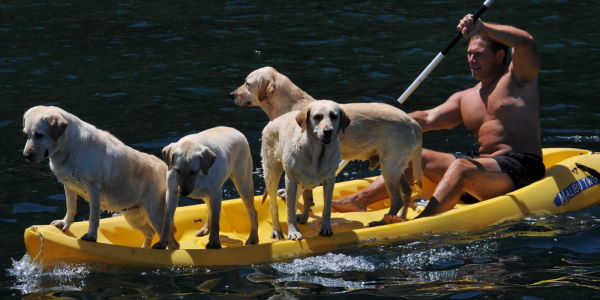
If you already have the kayak you’re using, you might not have many options. If are renting or contemplating buying a new kayak to go canine paddling, you’d be wise to take into consideration your pet’s requirements.
The most effective kayaks for dogs are boats that have larger decks or cockpits for obvious reasons.
Sit-on-top kayaks
Sit-on-top kayak and their open deck design allow plenty of room for Spot to roam around and feel comfortable and feel at ease. This is important for both of you. Be sure that your pet has plenty of space to lay down, while still giving you ample space to paddle.
The Sit-on-top kayak also offers a benefit to dog owners as well in addition to being more comfortable to climb in or out, a sit-on-top kayak will not sink or overflow with water should an agitated dog leap overboard or accidentally cause the boat to shake.
Closed-cockpit kayaks
Kayaks with a closed cockpit similar to traditional recreational kayaks could also be a great option with your canine. If you’re thinking of this type of kayak it’s worth considering a combination model that has an extra seat, or a kayak with an open cockpit that has Rover lying in between you and your feet.
Tandem kayaks
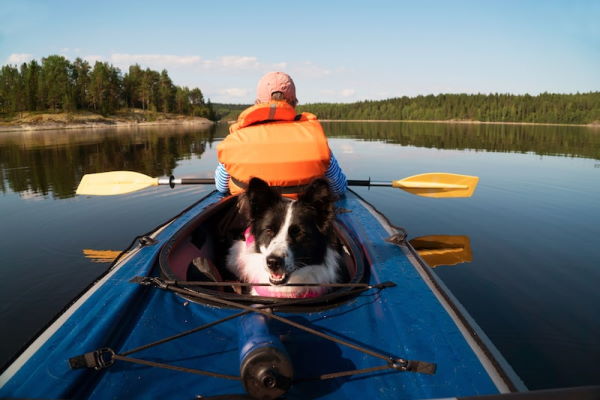
If you decide to go with the tandem kayak ensure that the dog is sitting in front while you steer back (dogs are notoriously poor with controlling). It is also important to be able to observe the actions of your dog throughout the day.
It is generally true that kayaks that have beams that are wider can provide more stability, particularly if you have a dog who likes to move around. If the space isn’t enough to allow your dog to be able to sit alongside you, ensure your dog can stand against the surface. A carpet or rubber that is held by the deck’s elastic storage ropes may provide extra grip for your dog.
Inflatable kayaks

Although it may sound counterintuitive, inflatable kayaks are the best option for those who intend to paddle with their pet. Some models like the Sea Eagle are built with more of a canoe-like appearance and higher walls which could act as a barrier to dogs who are inclined to leap out.
The majority of inflatable kayaks are constructed from a tough material that is strong enough to keep a dog’s claws out and, with the addition of many air chambers, even should a stray tooth or nail damage the vessel there’s no risk of sinking. The majority of top models come with simple repair kits.
In general, stay clear of sea kayaks or whitewater as they are small and unstable.
Conclusion
Kayaking with your dog can be a pleasant and relaxing experience.
If you don’t prepare and give attentiveness, you might discover yourself in a chaotic environment and may not be the best choice, even if proficient in kayaking.
The most important things and the quickest suggestions to remember are:
1) Think about your pet’s breed, size, and temperament as you select your kayak in line with their needs. A few of the best kayaks might not be appropriate for your dog.
2) Don’t throw your pet in at the bottom boats. Begin slowly and make sure they’re comfortable with the kayak as well as the essential commands for dry ground prior to going out onto the water.
3) Remember to pack a harness, a PFD leash sun cream, food, and water, as well as some sweets.
4) Stick to calm waters with there are no rapids. If you can take note of these four points and you’ll have a great and unforgettable time in the waters with your favorite furry friend.
Discover the ultimate guide on How to Kayak With a Dog. Unleash the secrets to a safe and enjoyable paddling experience for you and your furry companion. From essential training tips to choosing the right gear, explore the ins and outs of kayaking with dogs.
FAQ
What are the essential tips for kayaking with a dog?
Here are essential tips for kayaking with a dog:
Gradual Introduction: Introduce your dog to the kayak slowly and in a controlled environment. Allow them to get comfortable with the kayak on land before moving to the water.
Basic Commands: Teach your dog basic commands like “sit,” “stay,” and “lay down.” These commands will help you manage your dog’s behavior during the kayaking adventure.
Choose the Right Kayak: Select a stable and spacious kayak that accommodates both you and your dog comfortably. Look for kayaks designed with a dog in mind.
Dog-Friendly Life Jacket: Invest in a well-fitted life jacket specifically designed for dogs. This ensures their safety, especially in case of unexpected situations in the water.
Secure Your Dog: Use harnesses and leashes to secure your dog in the kayak, preventing sudden movements that could lead to capsizing.
Waterproof Gear: Pack essential items like dog treats, water, and a first-aid kit in waterproof bags to keep them dry and secure throughout the trip.
Check Water Conditions: Be aware of the water conditions, including currents and tides. Ensure that the weather is suitable for kayaking with your dog.
Energy Breaks: Take breaks for both you and your dog. Keep energy levels high with occasional snack breaks, and make sure your dog stays hydrated.
Familiarize with Paddling: Allow your dog to get accustomed to the paddling motion before hitting more challenging water. This helps reduce anxiety.
Dog’s Comfort: Consider your dog’s comfort level when choosing a kayaking location. Opt for places with dog-friendly policies to ensure a positive experience for both of you.
Training for Water Activities: If your dog is new to water activities, consider some pre-kayaking training sessions in shallow water to build their confidence.
Check Local Regulations: Be aware of any specific regulations or guidelines regarding kayaking with dogs in the area you plan to explore.
First Aid Awareness: Brush up on basic first aid for dogs and carry necessary supplies. It’s always good to be prepared for any unexpected situations.
Plan Short Trips Initially: Start with shorter kayaking trips to gauge your dog’s comfort and gradually progress to longer adventures.
Enjoy the Experience: Most importantly, have fun! Kayaking with your dog is about enjoying the outdoors together and building a stronger bond. Pay attention to their cues and ensure it’s a positive experience for them.
How to introduce a dog to kayaking?
Introducing a dog to kayaking requires patience, positive reinforcement, and a gradual approach to build their comfort and confidence. Here’s a step-by-step guide:
Familiarize with the Kayak:
Start by allowing your dog to inspect the kayak on dry land. Let them sniff and explore the kayak at their own pace.
Associate positive experiences by placing treats or toys around and on the kayak.
Onboard Without Water:
Once your dog is comfortable around the kayak, let them get on and off while it’s stationary. Use treats and encouragement to make it a positive experience.
Rocking the Kayak:
Gently rock the kayak while your dog is on board. This helps them get used to the movement without the added challenge of water.
Short Trips on Calm Water:
Choose a calm and shallow water area for the first experience.
Paddle very slowly to minimize water disturbances.
Positive Reinforcement:
Continuously offer treats and praise during the experience. Associate being in the kayak with positive feelings.
Frequent Breaks:
Keep the initial kayaking sessions short. Take breaks on land to allow your dog to relax and associate the breaks with a positive experience.
Gradual Water Exposure:
Gradually increase the time spent on the water and the distance traveled.
If your dog seems anxious, return to shallower water or dry land and try again.
Training Basic Commands:
Teach or reinforce basic commands like “sit,” “stay,” and “lay down” to maintain control during kayaking.
Accustom to Splashes:
Gradually introduce your dog to water splashes. Use a gentle approach, and if they are comfortable, progress to deeper waters.
Use a Dog-Friendly Life Jacket:
Acclimate your dog to wearing a life jacket. Start by letting them wear it on land for short periods, then in shallow water, before venturing into deeper waters.
Associate with Fun Activities:
Incorporate fun activities like fetching a floating toy while kayaking to make the experience enjoyable.
Positive Associations with Transportation:
Make the process of getting to the kayaking location positive. Associate car rides with exciting adventures.
Monitor Body Language:
Pay close attention to your dog’s body language. If they show signs of stress or discomfort, slow down or return to shore.
Consistency is Key:
Practice regularly to reinforce positive associations. The more familiar your dog becomes with kayaking, the more confident and comfortable they’ll be.
Celebrate Small Wins:
Celebrate each successful kayaking session with praise and rewards. Gradually, your dog will associate kayaking with positive experiences, creating a foundation for future adventures on the water.
What types of kayaks are best for paddling with dogs?
Choosing the right kayak when paddling with dogs is crucial for a safe and enjoyable experience. Here are considerations for selecting the best kayaks:
Sit-On-Top Kayaks:
These kayaks are often more stable and have an open design, making it easier for dogs to get on and off.
The open cockpit allows your dog to move around comfortably.
Stable Kayaks:
Look for kayaks with a wide and stable hull design, providing better stability on the water.
A broader base minimizes the risk of capsizing, especially with the added weight and movement of a dog.
Tandem Kayaks:
Tandem kayaks are larger and can provide more space for both you and your dog.
They often have higher weight capacities, accommodating the additional weight of a furry companion.
Inflatable Kayaks:
Inflatables can be a good option as they are often more stable than hard-shell kayaks.
They are also lightweight, making them easier to transport and store.
Kayaks with a Large Cockpit:
Opt for kayaks with a spacious cockpit that allows your dog to sit or lie down comfortably.
A larger cockpit provides more flexibility for your dog’s movements.
Dog-Friendly Features:
Some kayaks are designed with specific features for paddling with dogs, such as a dedicated dog area or attachment points for leashes.
Look for models that consider the needs of both the paddler and the dog.
Self-Bailing Kayaks:
These kayaks have drainage holes that allow water to exit, helping to keep the cockpit dry.
Self-bailing kayaks are advantageous if your dog tends to bring water into the kayak.
Kayaks with a Recessed Cockpit:
Kayaks with a recessed cockpit can prevent water from accumulating, offering a drier and more comfortable space for both you and your dog.
Adjustable Footrests or Foot Pegs:
Having adjustable footrests or foot pegs allows you to customize the space inside the kayak to accommodate your dog’s size.
Skeg or Rudder for Tracking:
A kayak with a skeg or rudder helps with tracking and maintaining a straight course, providing stability that can benefit both you and your dog.
Weight Capacity:
Ensure that the kayak has a sufficient weight capacity to accommodate both your weight and your dog’s weight comfortably.
Durable Materials:
Choose kayaks made from durable materials to withstand potential scratches from your dog’s claws.
Before making a purchase, consider your dog’s size, behavior, and comfort preferences. Testing the kayak in calm waters first will give you a better understanding of how well it suits both you and your canine companion.
How can I secure my dog in a kayak?
Securing your dog in a kayak is crucial for their safety and your peace of mind during paddling. Here are detailed steps on how to achieve this:
Use a Dog-Friendly Life Jacket:
Invest in a well-fitted life jacket specifically designed for dogs. Ensure it has a handle on top for easy lifting and maneuvering.
Introduce the Life Jacket Gradually:
Allow your dog to get accustomed to wearing the life jacket on dry land before taking them on the water. Use treats and positive reinforcement to create a positive association.
Harness and Leash:
Attach a harness to your dog, and then connect a leash to the harness. The harness provides more control and stability than attaching the leash to a collar.
Secure the Leash to the Kayak:
Use a short leash to connect your dog to the kayak. Attach the leash to a secure point on the kayak, avoiding moving parts or areas where your dog could become entangled.
Position Your Dog Strategically:
Place your dog in a position that ensures balance and stability. Ideally, they should be in an area where they can comfortably sit or lie down without obstructing your paddling.
Non-Slip Mat or Pad:
Consider placing a non-slip mat or pad in the kayak to provide your dog with better traction and prevent slipping.
Teach Basic Commands:
Ensure your dog knows basic commands like “sit,” “stay,” and “lie down.” These commands are useful for maintaining control and preventing sudden movements.
Practice in Calm Waters:
Start in calm and shallow waters for initial practice. This allows your dog to get used to the movement of the kayak and the sensation of being on the water.
Gradual Exposure:
Introduce your dog to kayaking gradually. Begin with short trips and gradually extend the duration as your dog becomes more comfortable.
Stay Calm and Reassuring:
Dogs can sense their owner’s emotions. Stay calm and reassure your dog with a soothing voice and gentle petting.
Use Positive Reinforcement:
Reward your dog with treats and praise for calm behavior and following commands. Positive reinforcement creates a positive association with kayaking.
Check for Comfort:
Ensure your dog is comfortable. Pay attention to signs of stress or discomfort, and make adjustments as needed.
Avoid Overloading the Kayak:
Be mindful of the kayak’s weight capacity. Avoid overloading the kayak with gear or additional passengers that could compromise stability.
Monitor for Signs of Anxiety:
Keep an eye out for signs of anxiety, such as excessive panting, whining, or restlessness. If your dog shows signs of distress, return to shore and try again later.
Secure Gear:
Secure any gear or equipment in the kayak to prevent it from accidentally shifting and startling your dog.
Remember that each dog is unique, and it may take time for them to feel completely at ease in a kayak. Patience, positive reinforcement, and consistent practice will help make the experience enjoyable for both you and your furry companion.
Can all dog breeds kayak?
While many dogs of various breeds can be trained to kayak and enjoy water activities, not all dogs are equally suited to this type of adventure. Here are some considerations:
Temperament:
Dogs with calm and easygoing temperaments often adapt better to kayaking. Breeds known for their water-loving nature, such as Retrievers, tend to take to kayaking more naturally.
Size:
Larger breeds may have an easier time balancing in a kayak, especially if it’s a tandem kayak with more space. However, smaller breeds can also enjoy kayaking if they are comfortable and secure.
Health and Age:
The health and age of the dog play a crucial role. Puppies, senior dogs, or dogs with health issues may not have the stamina or physical capability for kayaking.
Experience with Water:
Breeds that are naturally inclined towards water activities, like the Labrador Retriever or Portuguese Water Dog, may take to kayaking more easily.
Training:
The level of training and obedience is essential. Dogs that respond well to commands and have been trained for water activities are more likely to have a positive kayaking experience.
Comfort with Confined Spaces:
Some dogs may feel uneasy in the confined space of a kayak. Others, especially those used to car rides, may adapt more easily.
Coat Type:
Dogs with water-resistant coats, such as many Retrievers or Poodles, may find kayaking more comfortable. Breeds with thick, insulating coats might struggle in warmer weather.
Individual Preferences:
Each dog is unique, and individual preferences play a significant role. Some dogs may take to kayaking enthusiastically, while others may feel anxious or stressed.
It’s important to introduce your dog to kayaking gradually, observe their reactions, and make the experience positive through rewards and praise. If your dog shows signs of fear or discomfort, it’s crucial to respect their feelings and not force the activity.
Ultimately, the decision to take a dog kayaking depends on the individual dog’s personality, health, and comfort level. Always prioritize your dog’s well-being and safety, and consult with your veterinarian if you have concerns about your dog’s ability to engage in water activities.
What commands should I teach my dog before kayaking?
Before kayaking with your dog, teaching certain commands is crucial for safety, communication, and a positive experience. Here are essential commands to focus on:
“Sit”:
This command helps in getting your dog settled in the kayak and ensures they remain in a seated position, preventing sudden movements.
“Stay”:
Teaching your dog to stay is important for situations like boarding or exiting the kayak. It provides control and prevents them from moving around unpredictably.
“Lie Down”:
A lying-down position is more stable in a kayak. This command is useful for maintaining balance and stability during the paddling journey.
“Come” or “Here”:
The “come” command is crucial for calling your dog back to the kayak if they decide to explore the water or the shoreline.
“Leave It”:
Teaching your dog to “leave it” is essential in case they become curious about something in the water or on the kayak. It helps prevent unwanted interactions.
“No” or “Off”:
Use these commands to discourage undesirable behavior, such as jumping on and off the kayak without your signal.
“Wait”:
“Wait” is a command that helps your dog understand to pause or hold back. It can be helpful when you are boarding the kayak or need them to stay put temporarily.
“Up” or “Board”:
Teaching your dog a command to get onto the kayak is crucial for a smooth boarding process.
“Easy” or “Gentle”:
This command can be useful when your dog is excited or anxious. It signals them to be calm and gentle, minimizing sudden movements.
“Paddle” or “Go” (for Forward Movement):
If you are kayaking with a particularly well-trained dog, you can use commands to encourage forward movement. This is more advanced and depends on your dog’s aptitude for learning commands.
Consistent training, positive reinforcement, and patience are key when teaching these commands. Practice these commands in various environments, including around the kayak, to ensure your dog responds reliably. Use treats, praise, and encouragement to reinforce positive behavior, making the kayaking experience enjoyable and stress-free for both you and your furry companion.
Our best posts:
- Lifetime Kayak Reviews;
- Ideas and Suggestions for Funny Kayak Names;
- Best Ultralight Spinning Reel;
- Best Kayak Cart For Sand;
- Best Fish Finder For Kayak;
- Best Monofilament Fishing Line For Spinning Reels;
- Vibe Shearwater 125 Review;
- Best Kayaks for Dogs;
- Best Inflatable Kayak For Whitewater;
- Kayak Trolling Motors.
